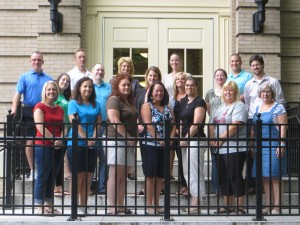The 2014 Summer PMI Workshops have finished!
Week 1, which ran July 14-18 was organized into a course called Mathematics as a Second Language. We had a total of 20 participants from the following districts:
- Bald Eagle Area SD
- Bellefonte Area SD
- Curwensville Area SD
- Harrisburg SD
- Reading SD
- State College Area SD
- Steelton-Highspire SD
- West Branch SD
- Williamsport Area SD
The participants ranged from a kindergarten teacher through some fifth grade instructors, as well as two participants with middle school and high school experience.
Week 1 was spent exploring arithmetic at a deeper level: picking apart models of understanding, the reasoning behind the procedures, and connections between the operations. We also spent time exploring education ideas such as the iceberg model and evaluating levels of cognitive demand. You can see the daily blog recaps for specifics of each day’s events.
Week 2 July 21-25 was organized into a course called Functions and Algebra. Sixteen of the twenty participants from Week 1 continued on into this week. Here we continued ideas of the previous week to consider proportional reasoning and linear relationships. Teachers of the later grades gained new intuitions while the earlier grades gained a longer view of the topics they teach. These topics also served to strengthen the procedural fluency gained in the first week. The morning discussions of pedagogy topics continued, as we consider issues such as equity in the classroom and the use of open-ended problems.
The workshops ran daily 9am to 4pm, in a style that could be described as “immersion.” Little time was spent in a traditional lecture format. The class time is primarily spent in collaborative problem-solving and discussion, akin to the style sometimes called “inquiry based learning.”
The next post will be on quantitative and qualitative analyses of the outcomes for the summer workshops.




